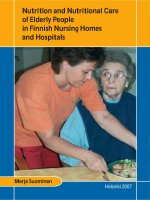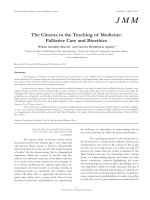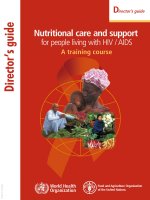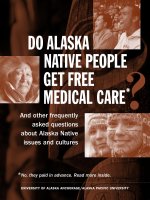Do Alaska Native People Get Free Medical Care And other frequently asked questions about Alaska Natives issues and cultures pptx
Bạn đang xem bản rút gọn của tài liệu. Xem và tải ngay bản đầy đủ của tài liệu tại đây (1.62 MB, 114 trang )
DO ALASKA
NATIVE PEOPLE
GET FREE
MEDICAL CARE
*
And other frequently
asked questions
about Alaska Native
issues and cultures
UNIVERSITY OF ALASKA ANCHORAGE/ALASKA PACIFIC UNIVERSITY
*No, they paid in advance. Read more inside.
?
Tanacross Athabascan
Upper Tanana
(Lower) Tanana
Koyukon
Han
Gwich'in
Upper Kuskokwim
Holikachuk
Deg Xinag (Deg Hit’an)
Dena’ina (Tanaina)
Ahtna
Eyak
Tlingit
Haida
Tsimshian
Yupik
Siberian Yupik / St. Lawrence Island
Central Yup’ik
Inupiaq
Alutiiq
Unangax (Aleut)
DO ALASKA
NATIVE PEOPLE
GET FREE
MEDICAL CARE
*
And other frequently asked
questions about Alaska
Native issues and cultures
*
No, they traded land for it. See page 78.
Libby Roderick, Editor
UNIVERSITY OF ALASKA ANCHORAGE/ALASKA PACIFIC UNIVERSITY
2008-09 BOOKS OF THE YEAR COMPANION READER
?
Copyright © 2008 by the University of Alaska Anchorage and Alaska Pacific University
Published by:
University of Alaska Anchorage
Fran Ulmer, Chancellor
3211 Providence Drive
Anchorage, AK 99508
Alaska Pacific University
Douglas North, President
4101 University Drive
Anchorage, AK 99508
Limit of Liability/Disclaimer of Warranty: While the editors, contributors, and publishers
have made their best efforts in preparing this volume, they make no representations or
warranties with respect to the accuracy or completeness of the contents. This book is
intended as a basic introduction to some very complicated and highly charged questions.
Many of the topics are controversial, and all views may not be represented. Interested
readers are encouraged to access supplemental readings for a more complete picture.
This project is supported in part by a grant from the Alaska Humanities Forum and the
National Endowment for the Humanities, a federal agency. Any views, findings,
conclusions, or recommendations expressed in this publication do not necessarily
represent those of the National Endowment for the Humanities.
ISBN: 978-1-4276-3215-9
FORWARD
Three years ago, Alaska Pacific University and the University of Alaska Anchorage
embarked on a ground-breaking partnership to enhance the learning climate on our
campuses, with the stated goal of making them more inclusive of minority voices and ways
of knowing and safer places for the free exchange of ideas. The partnership was awarded a
grant through the Ford Foundation’s Difficult Dialogues initiative, and since then nearly sixty
of our faculty members have come together to re-examine the tools of productive civil
discourse. Many others have joined them in discussions of controversial topics related to
race, class, culture, science, religion, business, politics, and social justice with a new
consciousness and purpose.
These efforts have started an important transformation on our campuses that we hope will
continue and deepen in the years ahead. The Books of the Year program is one outcome: a
chance for our two universities to share common readings and address together a common
theme. This year’s theme, “Alaska’s Native Peoples: A Call to Understanding,” is especially
important to all Alaskans. We urge our faculties and students—as well as staff, administra-
tors, and community members—to take this opportunity to learn more about Alaska’s
indigenous peoples. We invite you to start with the Books of the Year and this companion
reader, but we hope you will not stop with them. As you read these books and explore other
resources, we also urge you to ask new questions and to respect and acknowledge the
complexity you discover in each new answer.
This inquiry is at the heart of higher education. We invite you to embark with us on this jour-
ney towards a greater understanding of the peoples, cultures, histories, and values of our fel-
low citizens, the first Alaskans.
Sincerely,
Fran Ulmer, Chancellor Doug North, President
University of Alaska Anchorage Alaska Pacific University
INTRODUCTION
Welcome to the companion reader to the UAA/APU Books of the Year for 2008-09!
The Books of the Year are Yuuyaraq: The Way of the Human Being by Yup’ik writer Harold
Napoleon and Growing up Native in Alaska by Anchorage historian Alexandra J.
McClanahan. Yuuyaraq outlines the devastating impact of epidemic diseases that wiped out
so many of the Native culture-bearers between the late 18th and early 20th centuries.
Growing up Native in Alaska includes interviews with 27 of today’s young Alaska leaders
about their lives, their futures, and the innovative and creative ways they are finding to “live
in two worlds.”
We offer this companion reader to provide additional context for our theme this year. It
includes responses to some frequently asked questions about Alaska Native issues and cul-
tures and a bibliography of recommended readings to deepen your understanding of the
issues involved. Responses were written by Alaska-based individuals and scholars within our
community and reviewed by the UAA/APU Book of the Year committee. Neither the
responses nor the readings are intended to speak for all Native people or to represent the full
range of opinion on any one subject; instead we hope you’ll use the responses and readings
as entry points to a deeper exploration and richer discussion of the complex and compelling
issues that are part of Alaska Native life today. Most readings pertain to several disciplines;
wherever possible, we have provided annotations and suggested excerpts of the most
relevant passages.
Hard copy readings can be found at the UAA/APU Consortium Library, the Loussac Library,
or through interlibrary loan. Online readings can be found on our web site:
Many of the online readings are original works,
never before published. Others are links to materials found on other web sites. We will make
every effort to keep the links intact and to add new materials as we discover them; however,
we apologize in advance if a particular document becomes unavailable for any reason in
the future.
The questions, responses, and readings are hardly exhaustive, but we have high hopes for
them nonetheless. We hope this reader prompts many Alaskans to investigate the wonderful
resources that already exist and that this collection–-essentially a “work in progress”—
inspires others to create a truly comprehensive set of resources for teaching and learning
about Alaska Native cultures, identities, histories, and issues.
We invite you to participate in university and public events throughout the year (keep an eye
on our web site for full details). We would especially like to call your attention to the Alaska
Native Oratory Society (AkNOS), a learning community and series of speaking events and
competitions that provide opportunities for Alaska Native, Native American, and non-Native
high school and university students to develop oratory skills and learn about Native issues.
At regional and statewide events, participants compete for cash prizes in four speech cate-
gories: Oratory, Declamation, Storytelling, and Native Languages. For more information on
AkNOS, please visit or call the UAA Alaska Native
Studies Department at 786-6135.
It is our hope that the 2008-09 Book of the Year program will inspire rich discussions that
bring Alaskans a deeper understanding of one another and of the issues that affect us all.
Renee Carter-Chapman,
University of Alaska Anchorage
and the UAA/APU Book of the Year Committee
Marilyn Barry,
Alaska Pacific University
ACKNOWLEDGEMENTS
Many people worked very hard to create this reader in a very short time. We deeply
appreciate their efforts.
Contributors and Readers
Loren Anderson
Susan Anderson
Bruce Batten
Hallie Bissett
Dr. Jeane Breinig
Dr. Jeanne Eder
Dr. Phyllis Fast
Hazel Felton
Matthew Gilbert
Heather Kendall-Miller
Jim LaBelle
Aaron Leggett
Alexandra J. McClanahan
Thanks also to: Ray Barnhardt, Brian Brayboy, Debi Bye/Anchorage School District Title
VII Indian Education, Doreen Brown, Steve Colt, John Dede, Barbara Hedges,
Lisa Jamieson, Randi Madison, Richard Nelson, George Owletuck, Andy Page, Diane Purvis,
Lori Seagars, Marie Stewman, Yaso Thiru.
Book of the Year Committee Members
Dr. Jeane Breinig, UAA Department of English
Lauren Bruce, UAA Communication Department
JoAnn Ducharme, UAF Department of Alaska Native and Rural Development
Dr. Phyllis Fast, UAA Anthropology and Liberal Studies
Alexandra McClanahan, Cook Inlet Region, Inc.
Paul Ongtooguk, UAA College of Education
Rosanne Pagano, APU Department of Liberal Studies
Dr. Tim Rawson, APU Department of Liberal Studies
Libby Roderick, Chair, UAA Center for Advancing Faculty Excellence
Dr. Beth Sullivan, APU Rural Alaska Native Adult Distance Education
Dr. Edna Maclean
Helen McNeil
Ilarion (Larry) Merculieff
Paul Ongtooguk
Evon Peter
Libby Roderick
John Shively
Kelly Springer
Vera Starbard
Kristin Tolbert
The Alaska Native Heritage Center
The CIRI Foundation
Southcentral Foundation
Editor
Libby Roderick, UAA Center for Advancing Faculty Excellence
Editorial Assistant
Liisa Morrison, UAA Center for Advancing Faculty Excellence
Associate Editor
Kay Landis, UAA Office of the Senior Vice Provost
Copy Editors
Jean Ayers, Independent Clause
Paola Banchero, UAA Department of Journalism and Public Communications
Graphic Design
David Freeman
Photos
Photos courtesy of Clark James Mishler, Michael Dinneen, David Freeman, the Alaska
State Library Historical Collection, and UAA Archive and Special Collections.
On the cover:
Philip Blanchette and John Chase sing and beat traditional Yup’ik drums at the Alaska
Native Heritage Center. Kenny Toovak, Inupiat Elder from Barrow. Sophia Chya and
Serenity Schmidt with traditional Alutiiq headdresses and face tattoos. Photos by Clark
James Mishler.
Map
Language map courtesy of Alaska Native Language Center, University of Alaska
Fairbanks.
Printing
Printing made possible through the generous support of the Alaska Humanities Forum
and UAA’s Chancellor’s Cabinet.
TABLE of CONTENTS
Identity, Language and Culture 1
Who are Alaska’s Native peoples? 2
What is important to know about Alaska Native cultures? 4
How many Native languages are there? Is it important to save them? 6
Alaska Native Claims Settlement Act
and Corporations 19
What is the Alaska Native Claims Settlement Act (ANCSA)? 20
How did Alaska Native corporations start up? 22
Do all Alaska Native people get dividends? 23
What do Alaska Native people think of ANCSA? 24
Subsistence and Relationship to Land, Waters
and Wildlife 29
Do Alaska’s Native peoples want subsistence hunting and fishing rights that are
different from non-Natives? 30
Why are the land and waters so important to Native cultures? 33
What do the phrases “traditional ways of knowing” or “traditional knowledge
and wisdom” mean? 35
How is climate change affecting Alaska Native communities? 36
Do some Native corporations and organizations support drilling, mining, and
logging on their lands? 38
Tribal Government 57
Are there tribal governments in Alaska? 58
Are there reservations in Alaska? 59
Why are there no casinos in the state? 60
Effects of Colonialism 63
Why do we hear so much about high rates of alcoholism, suicide, and violence in
many Alaska Native communities? 64
What is the Indian Child Welfare Act? 67
Education and Healthcare 73
How are traditional Alaska Native ways of educating young people different from
non-Native educational practices? 74
Is the dropout rate for Alaska Native high school and college students higher than
rates for other students? 76
Why are some scholarships for Alaska Native students only? 77
Do Alaska Native people get “free” medical care? 78
The Future 87
What does the future look like for Alaska Native communities and cultures? 88
Where do we go from here? 90
Additional Resources 95
General 95
Alaska Native History Timelines 96
Cultural Sensitivity 97
University Resources 98
Sources for quotations used in this book 99
Sophia Chya and Serenity Schmidt with traditional Alutiiq headdresses and face tattoos.
Clark James Mishler
Identity, Language and Culture
Who are Alaska’s Native peoples?
What is important to know about Alaska Native cultures?
How many Native languages are there? Is it important to
save them?
“First, who we are. . .we are Inupiaq, Yup’ik, Cup’ik, Siberian Yupik, Tlingit,
Haida, Tsimshian, Eyak, Athabascan, Aleut, and Alutiiq. We are the
indigenous people of Alaska. For over 10,000 years our ancestors have
lived and thrived in one of the harshest areas of the world. We are the last
remaining indigenous people in the United States to have never been
forcibly removed from our homelands and settled in reservations. We have
more than 230 small villages scattered in the largest land mass contained
in one state of the union. The residents of many of these Native villages
depend on subsistence hunting and fishing to sustain their bodies as well
as their traditions and cultures.”
Sheri Buretta
1
2
Who are Alaska’s Native peoples?
The term “Alaska Native” is used to describe the peoples who are indigenous to the lands
and waters encompassed by the state of Alaska: peoples whose ancestors have survived here
for more than ten thousand years.
Distinct cultural groups. Alaska Native people belong to several major cultural groups—
Aleut/Unangan, Athabascan, Eyak, Eskimo (Yup’ik, Cup’ik, Siberian Yupik, Sugpiaq/Alutiiq,
Inupiaq), Haida, Tlingit, Tsimpshian—and many different tribes or clans within those group-
ings. Each of these cultures is distinct, with complex kinship structures, highly developed
subsistence hunting and gathering practices and technologies, and unique and varied
languages, belief systems, art, music, storytelling, spirituality, and dance traditions, among
many other attributes.
Common values. What these cultural groups share in common, however, are deeply-
ingrained values, such as honoring the land and waters upon which life depends, having
respect and reverence for fish and wildlife, valuing community over individuality, sharing
with others, and respecting and learning survival skills and wisdom from Elders. Alaska
Native cultural worldviews are holistic. Native cultures accept that everything in creation is
connected, complex, dynamic, and in a constant state of flux. Alaska Native peoples have a
deep and sophisticated qualitative understanding of the environment in which they live. This
understanding comes from stories passed down for generations; it also comes from life expe-
riences, learning from mentors beginning at a young age, observations of others in the com-
munity, and the guidance of Elders.
Geography. The different Alaska Native cultural groups today inhabit the lands they have
occupied for more than ten thousand years. The Inupiaq people live in the Arctic; the Yupiaq
live in Southwestern Alaska; the Unungan live in the Aleutian Chain and Pribilof Islands; the
Athabascan live in the Interior and Southcentral part of the state; the Tlingit, Haida, and
Tsimpshian live in Southeastern Alaska; and the Sugpiaq and Eyak occupy the lower
Southcentral region, Kenai Peninsula, and Kodiak. Many now have moved to urban areas,
because of economic pressures impinging on the villages and because opportunities for jobs
and education are greater. Although it is difficult to estimate what the overall population was
in early history, stories and archeological investigations prove that Alaska Native people used
and occupied virtually all inhabitable land in the 586,412 square mile terrain we now
call Alaska.
3
Population. Today more than 100,000 Alaska Native individuals live in Alaska,
1
with many
more whose ancestry includes some strand of Alaska Native heritage. Until about 1930,
Alaska Native people are estimated to have accounted for between fifty percent and a hun-
dred percent of Alaska’s population. Due to the influx of non-Natives, however, Alaska
Native citizens now represent approximately sixteen percent of the state’s population.
2
Most
live in small rural communities accessible only by air or boat. Roughly six percent of
Anchorage citizens (approximately 17,000) are of Alaska Native descent.
3
Nearly one-quarter
of Alaska schoolchildren from kindergarten through grade 12 are Alaska Native.
4
Politics and economics. Alaska Native people are vitally involved in the political and eco-
nomic landscape of modern Alaska. The Alaska Native Brotherhood (founded in 1912), the
Tlingit and Haida Central Council (1939), Alaska Native Sisterhood, the Tundra Times news-
paper (1962), the Alaska Federation of Natives (1966), the Inuit Circumpolar Conference
(1975), and many other organizations, tribal leaders, Native legislators, and individuals have
helped shape key political issues including subsistence, land claims, civil rights, education,
cultural and language preservation, energy cost and alternatives, and climate change.
Map courtesy of Alaska Native Language Center, University of Alaska Fairbanks.
4
What is important to know about Alaska Native cultures?
An attempt to answer this question fully has engaged many scholars, Elders, and educators
for hundreds of years. Here are some fundamentals:
Alaska Native cultures:
■ have developed over thousands of years in response to environmental conditions among
the most challenging on earth.
■ are many and varied, representing at least seven major groups across the state –
Aleut/Unangan (Southwestern Coastal Alaska), Inupiaq (Northwestern and Northern
Coastal), Athabascan (Interior), Tlingit (Southeastern), Tsimpshian (Southeastern), Haida
(Southeastern), Eyak (Southeastern), Yup’ik, Cup’ik, Siberian Yupik, Sugpiaq/Alutiiq
(Southwestern), with many different tribes or clans within those groupings.
1) Alaska Department of Labor & Workforce Development. 2006. “Alaska Population Projections 2007-2030.”
2) Statewide Library Electronic Doorway. />3) U.S. Census Bureau. 2006. Quick Facts.
4) Department of Education Alaska Department of Education and Early Development. “Accountability and Assessment Total Statewide Enrollment
by Ethnicity, Grade and Percent as of October 1, 2006.”
www.eed.state.ak.us/stats/StatewidebyEthnicity/2007Statewide_Gr_X_Ethnicity.pdf
5) McClanahan, Alexandra J. “Alaska Native Corporations — Ch’etbuja: We Share It, A Look at 13 Native Regional Corporations and 13 Native
Village Corporations.” 2006. Association of ANCSA Regional Corporation Presidents/CEOs.
/>Following passage of the Alaska Native Claims Settlement Act (ANCSA) in 1971
and establishment of thirteen regional and over 200 village corporations, Alaska Native
peoples collectively have become among the most powerful economic forces in the state (see
also pages 19-26). According to the Calista Corporation Report of 2006, Native corporations
have combined revenues of more than $4 billion, pouring huge sums into the Alaska econo-
my through job creation, business investments, dividends, and charitable contributions.
5
However, many corporations are still struggling to realize financial gains for shareholders,
and many Alaska Native people in rural areas live near poverty levels and depend upon hunt-
ing and fishing to survive. Alaska permanent fund dividends and government aid are signifi-
cant sources of income in many rural households.
As history has shown, important decisions regarding Alaska’s environment, public
education, and economy depend on an understanding of Alaska Native histories and cultures.
Readings in this section help explain some aspects of Alaska Native identities and cultures
and the role they play in shaping Alaska today and tomorrow.
5
■ are distinct from one another, with unique and varied languages, complex kinship struc-
tures, and highly developed subsistence hunting and gathering practices and technologies,
belief systems, art, music, storytelling, spirituality, and dance traditions, among others.
■ share key values, such as honoring the land and waters upon which life depends; respect-
ing and sharing with others; respecting and learning from Elders; living with an attitude of
humility and patience; honoring the interconnections among all things; being mindful in
word and deed; knowing one’s place in the context of one’s history, traditions, and ancestors.
■ are completely rooted in and tied to the land and waters of a particular region and the
practices and customs necessary to thrive in that region.
■ have been hard hit by myriad forces over the past two centuries, including diseases
brought by European immigrants and traders; enslavement and oppression by colonizing
powers (including the United States government, territorial gov-
ernment, Russian government, and religious organizations); a
huge influx of non-Natives, which has altered access to subsis-
tence foods and resulted in restrictive regulation; the arrival of
western technologies, religions, economic systems, industrial
development, and educational systems; and climate change.
Despite these obstacles, Alaska’s Native peoples not
only continue to survive, but also help define Alaska’s
economy, politics, and future.
It is important to note that traveling to the remote vil-
lages where most Alaska Native people live is, for non-Natives,
like traveling to a foreign country in every sense of the word. A
casual observer may note that Alaska Native individuals appear
to be “Americanized” in that they use modern tools, clothes,
and machinery, and most speak English and wear western
clothes. But the bulk of Alaska Native identity is beneath the surface. Each village has differ-
ent relationship and communication protocols, different customs and traditions, and different
worldviews even within a single region of Alaska; these differences are magnified when con-
sidered against other indigenous cultures and mainstream society.
Alaska Native peoples have had intimate contact with their immediate environments
for hundreds of generations and thus have a profound understanding of place. Development
of oil reserves on Alaska’s North Slope in the 1970’s introduced a new tension when Alaska
Native aboriginal land claims impeded construction of the 800-mile trans-Alaska pipeline.
Most Alaska Native land claims were extinguished by congressional action in 1971, a solu-
tion that remains a topic of dispute today (see section on ANCSA, pages 19-26).
Alaska Native history is fraught with stories of conflict with western legal systems
(particularly over land) and with western theories about land, fish, and wildlife, as well as
“For far too long we Dena’ina
people have been trying to tell
our story in other people’s
words. This may explain some
of why we’ve been almost
invisible in our own country,
even among ourselves.”
Clare Swan
6
How many Native languages are there?
Is it important to save them?
Alaska is home to twenty Alaska Native languages, along with a multitude of regional
dialects. In Native cultures, as in every culture, language serves as a vessel for entire ways of
thinking and relating to the world: a storehouse of accumulated knowledge, wisdom, infor-
mation, philosophical views, sense of place, history, relationships, social and political organi-
zation, identity, learning styles, beliefs, and attitudes about everything from food to land to
marriage to spirituality. Language expresses the unique cumulative, shared experience of a
group of people over generations and offers the rest of the human race another view of how
to live in the world.
From indigenous peoples’ perspectives, language is birthed from the land in which
the people themselves live and contains the vibration of these lands in the sounds of the
words used. Each spoken tongue is unique, the result of thousands of years of living in a spe-
cific area. An adopted or second language can never replicate what a particular indigenous
language can communicate.
Alaska Native words and languages are multi-dimensional in meaning. Some words
or phrases communicate not only information, but also spiritual and emotional dimensions
reflective of the holistic worldview of Alaska Native peoples. This is why Alaska Native
Elders often speak in their own language rather than in English in group settings, even when
speaking to an English-only group. To them, the English language cannot convey the depth
of meaning their own language can.
The destruction or erosion of the languages of Native peoples all around the planet
is of central concern to indigenous nations, anthropologists, linguists, and people of all back-
grounds who understand the value and necessity of preserving cultural, linguistic, and intel-
lectual diversity on behalf of the human future. Of the 6,000 languages spoken around the
globe, linguists fear that up to 90 percent could disappear by the next century.
individual versus communal rights–struggles some Native people believe may only heighten
as Alaska continues to attract newcomers who know little, if anything, about Alaska’s first
peoples.
Alaska’s Native peoples have a deep understanding and wisdom about fish, wildlife,
habitat, weather, climate, and geography that could benefit all peoples. As environmental
issues grow ever more daunting—even threatening the survival of all life on this planet—
Alaska Native cultures, worldviews, knowledge, and wisdom offer alternatives for living in a
respectful and sustainable relationship with the natural world.
7
Native languages in Alaska are suffering some of the greatest losses. Out of the
twenty languages, seventeen have 300 or fewer speakers remaining.
6
Marie Smith Jones,
Chief of the Eyak nation and the last surviving speaker of the Eyak language (a 3,000-year
old language from Southcentral Alaska), died in January 2008. Although she and others
worked very hard to pass the Eyak language to the next generation, there is now no one
alive today for whom Eyak was a primary tongue and fundamental way of understanding
the world.
Native languages have been endangered or eroded by the forces of colonization for
the past several hundred years. Beginning with their arrival in the 1700s, many missionaries,
government officials, and educators actively promoted policies and practices aimed at
destroying or marginalizing the languages spoken by Native peoples, acting on a misguided
belief that forcing Alaska Native peoples to abandon their tradi-
tional ways and become like “white” people was a progressive
act. With a few notable exceptions, most mission or boarding
schools (including those attended by many Native adults living
today), forbade Native children from speaking their own lan-
guages and harshly punished them if they persisted. By breaking
the linguistic bonds that tied children to their cultures and Elders,
a chasm opened up between many Alaska Native Elders and
youth. Much vital knowledge and wisdom was lost.
Unlike immigrants to the United States who gave up
their original languages to assimilate, indigenous peoples of the
United States have no country of origin to which they may return
and in which their native tongue is still being spoken. Italian-
Americans may return to an Italy where their traditional language
is still actively used; Chinese dialects are still alive to Chinese-
Americans who wish to reconnect with linguistic and cultural roots. Without denying losses
and struggles that descendants of immigrant groups face, it must be acknowledged that
Alaska Native peoples are in a very different position. Alaska Native peoples are living on
their ancestral lands; if they lose their cultures, lands, languages—or all of these—there is
nowhere else to return to. Those languages, and the ways of living, connecting to and view-
ing the world they represent, will be lost forever.
In spite of recent efforts to marginalize Alaska Native languages (such as the
“English-only” laws passed overwhelmingly by voters in 1998, which sought to require that
all official businesses in the villages take place in English alone), many efforts have been
underway for the past few decades to document and pass on Alaska Native languages. Many
schools throughout Alaska now offer bilingual programs. The Fairbanks-based Alaska Native
“Human relationships are
embedded in the grammar and
become a subconscious part of
the … soul If we are to truly
understand this place, we have
to understand the language of
this place.”
Alan Boraas
6 Krauss, Michael, “The Vanishing Languages of the Pacific Rim,” 2007 (Anchorage Daily News, Wed. Jan 23, 2008, page A10.)
8
“Languages…shape thought and epistemological modes of learning. Take
this Iñupiaq term: aavzuuk. First, it is a complete sentence meaning
‘constellation consisting of two stars which appear above the horizon in late
December, an indication that the solstice is past and that days will soon
grow longer again.’ …Structurally polysynthetic, the Iñupiaq language allows
the speaker to economize on sound to maximize meaning with simply
inclusion and replacement of key morphemes. Such morphemes are explicit
in terms of direction, number of speakers, number of listeners, height from
the horizon line, and time. Second, in this example Inupiaq epistemology
makes use of language to impart astronomical knowledge of the
constellations, calendric data, and patience about the presence or absence
of light. Implied within the term, aavzuuk, is the suggestion that the Iñupiaq
speaker will learn what to expect of the environment and other creatures in it
at this time of year. Thus, the Iñupiaq sense of a maturing self grows with
knowledge of the language. ”
Dr. Phyllis Fast
Language Center and a host of other sites offer online resources. UAA offers classes in the
Yup’ik language, and the statewide Alaska Native Oratory Society competition at UAA
recognizes high school and college students who can speak their traditional languages.
Many oral history projects seek to document the speech of Elders from various
regions, and Alaska Native Elders and leaders throughout the state are encouraging young
people to learn to speak their original languages. Being able to speak both English and
traditional languages is a strength that will allow these young people to walk in two worlds
and retain a valuable heritage for their children and the rest of humanity.
9
Blanket toss at the World Eskimo Olympics in Fairbanks.
Clark James Mishler
11 0
Online Readings
Bissett, Hallie. “I am Alaska Native.”
Recent UAA graduate and current MBA student, Dena’ina Athabascan Hallie Bissett
discusses her struggle to understand her indigenous identity. She not only comes to terms with her
culture, but also realizes how central it is to her life.
Breinig, Jeane. “Alaska Native Writers, Alaska Native Identities.”
Jeane Breinig, Ph.D., Haida, is currently a UAA Associate Professor of English. In this essay,
Breinig discusses how four Alaska Natives writers portray aspects of their contemporary identities,
while still maintaining connections to their respective cultural traditions.
Breinig, Jeane. “Inside the Circle of a Story.”
This family story discusses the role of Haida oral traditions, storytelling, and language
revitalization in Southeast Alaska. It includes links to writing by Dr. Breinig’s mother Julie Coburn.
Bruchac, Joseph W. III. “We are the In-betweens: An Interview with Mary TallMountain.” Studies in
American Indian Literatures
, Series 2, Vol. 1, Num.1 (Summer 1989).
Interview with nationally renowned Koyukon-Athabascan writer (who was adopted into a white
family at the age of six) about her life and writings.
Burch, Ernest S., Jr. “From Skeptic to Believer: The Making of an Oral Historian.”
Ernie Burch, Jr., Ph.D., social anthropologist, specializes in the early historic social organization of
the Inupiaq. In this essay, he argues for the validity of using Native oral histories to truly
understand the historical record. He contends that oral histories are often ignored or misunderstood
by academics, and argues for their inclusion in research projects.
Davis, Robert. “Saginaw Bay: I Keep Going Back.” Poem. Tlingit Tribal Art web site.
Fast, Phyllis. “Alaska Native Language, Culture, and Identity.” Essay, 2008.
Phyllis Fast, Ph.D., Athabascan, is UAA Associate Professor of Anthropology. She is also an author
and an artist. In this essay, Fast discusses the value of pre-colonial religious traditions and
language, as well as the post-colonial impact of the Alaska Native Claims Settlement Act (ANCSA)
of 1971 and the ANCSA 1991 Amendments of 1988.
Please visit our web site at
/>for a variety of supplemental readings
READINGS
11
Garza, Dolly. “The Origin of ‘Tlingit Moon and Tide.’”
Dolly Garza, Ph.D., Tlingit and Haida, explains the educational and cultural function of a
Tlingit story.
Hensley, Willie. “Speech at Bilingual Conference.” Anchorage, 1981.
William Hensley, Inupiaq, architect of ANCSA, reflects on key issues regarding the relationship
between schooling, education, and the future of Alaska Native cultures in a 1981 speech to the
annual Bilingual/ MultiEducation Conference.
Jacobson, Steven A. “Central Yup’ik and the Schools.”
This handbook was designed to assist school districts in providing effective educational services to
students from the Yup’ik language group. This is one of three handbooks developed to increase
school districts' and school personnel's understanding of selected Alaska Native language groups.
Maclean, Edna Ahgeak. “Why Don’t We Give Our Children to Our Native Languages?”
Edna Maclean, Ph.D., Inupiaq, former president of Iligsavik College, provides an overview of the
effects of education on Alaska Native languages, a discussion of the State of Alaska's approach to
bilingual education, and suggestions for ways to revive and maintain Alaska Native languages.
Oquilluk, William. “People of Kauwerak: Legends of the Northern Eskimo.”
William Oquilluk, Inupiaq from Point Hope (1896-1972), wrote down these stories of his people
when he was concerned they would be lost without written documentation. This excerpt from his
book focuses on one of the disasters that befell the people.
TallMountain, Mary. “Indian Blood.”
Poem by nationally renowned Koyukon Athabascan writer.
Thompson, Chad. Athabaskan Languages and the Schools: A Handbook for Teachers.
Jane McGary, Ed. Alaska Native Language Center, 1984.
Chad Thompson, Ph.D., linguist, describes the job of a linguist and provides an overview of
Athabascan languages.
Williams, Brad. “A Bridge Between Two Worlds: the term half breed gets a new definition.”
True North, Spring 1999.
Brad Williams, reporter for
True North, interviews several “mixed identity” Alaska Native citizens,
including Jack Dalton, Tim Gilbert, and Priscilla Hensley, who describe their struggles to come to
terms with who they are today.
Other Web Sites of Interest
Alaska Native Language Center:
Internationally recognized, the ANLC was established in 1972 by state legislation as a center for
documentation and cultivation of the state's 20 Native languages. Housed at the University of
Alaska Fairbanks, ANLC publishes research in story collections, dictionaries, grammars, and
research papers. ANLC also maintains an archival collection of more than 10,000 items.
11 2
Sealaska Heritage Institute.
Online resources promoting language restoration of Tlingit, Haida, and Tsimpshian languages.
Hard Copy Readings
Breinig, Jeane. “Alaskan Haida Narratives: Maintaining Cultural Identity Through Subsistence,” in
Telling the Stories: Essays on American Indian Literatures and Cultures, Malcolm A. Nelson and
Elizabeth Hoffman Nelson, eds., Peter Lang Publishing, 2001.
Breinig, Jeane. “ Alaskan Haida Stories of Language Growth and Regeneration” in American Indian
Quarterly
30 (Winter/Spring 2006): 110-118.
Bruchac, Joseph, ed., Raven Tells Stories, Greenfield Center, NY: Greenfield Review Press, 1991.
Collection of creative writing (primarily poetry) which includes briefs interviews with selected
authors who address aspects of their contemporary Native identity. Also includes biographies and
writings by Tlingit writers Robert Davis and Diane Benson among others.
Brown, Emily Ivanoff. Tales of Ticasuk: Eskimo Legends and Stories. Fairbanks, AK: University of
Alaska Press, 1987.
Emily Ivanoff Brown, from Unalakleet (1904-1982), was a grade-school teacher and advocate of
bilingual education. She is recognized by Alaska Native people as an important educator. Emily's
Native name "Ticasuk" means: "Where the four winds gather their treasures from all parts of the
world…the greatest of which is knowledge.” This book is a collection of her writings, focusing on
the oral stories of her people.
Brown, Emily Ivanoff. The Roots of Ticasuk: An Eskimo Woman’s Family Story. Portland, OR: Alaska
Northwest Publishing Company, 1981.
Collection of stories by Ivanoff. Revision of master’s thesis from University of Alaska published as
a book,
Grandfather of Unalakleet, in 1974; later published as The Roots of Ticasuk.
Christianson, Susan Stark. Historical Profile of the Central Council: Tlingit and Haida Indian Tribes
of Alaska.
Central Council Tlingit and Haida Indian Tribes of Alaska, 1992, Revised edition.
Early history of the movement of the Tlingit and Haida peoples to keep their traditional lifestyle
and ancestral lands.
Crowell, Aron L., Amy P. Steffian, Gordon L. Pullar, eds. Looking Both Ways: Heritage and Identity
of the Alutiiq People.
Fairbanks, AK: University of Alaska Press, 2001.
Combines, archaeology, history, and oral tradition of the Alutiiq people to trace a path through
ancestral generations to contemporary life.
13
Dauenhauer, Nora M., Life Woven with Song. Tucson, AZ: University of Arizona Press, 2000.
Collection of poems, plays and essays written by noted Tlingit scholar who provides readers with
creative expressions of her cultural traditions.
Dauenhauer, Nora and Richard Dauenhauer, eds., Haa Kusteeyí, Our Culture: Tlingit Life Stories:
Classics of Tlingit Oral Literature,
vol. 3., Seattle: University of Washington Press, 1994.
Recommended excerpts:
■ Pages 3-23, “Introduction: The Context of Tlingit Biography,” including “Tlingit Geography and
Social Structure” and “The Concept of At.óow” (Tlingit culture and its understanding of ownership
and belonging.)
■ Pages 525-544
Dauenhauer, Nora and Richard Dauenhauer, eds. Haa Shuká, Our Ancestors: Tlingit Oral
Narratives.
Seattle: University of Washington Press and Sealaska Heritage, 1987.
Recommended excerpt:
■ story told by Susie James about Glacier Bay history.
Dunham, Mike. “Voice for the Voiceless: Mary TallMountain.” Anchorage Daily News, Lifestyles
Section,
November 13, 1994.
Story about the life of nationally renowned Koyukon Athabascan writer (1918-1994) who was
adopted out of her family at age six due to the tuberculosis that ravaged Alaska and her village. The
story describes her life, the obstacles she overcame, her return to Alaska, and how she used writing
as a form of healing. Examples of her creative writing are included: “Indian Blood” (poem) and
“You Can Go Home Again” (essay).
“Elizabeth Wanamaker Peratrovich/Kaaxgal.aat and Roy Peratrovich, Sr. Lk’uteen.” From the
private collection of Joanne Ducharme.
Biography of Roy and Elizabeth Peratrovich and an overview of their fight for equal rights.
Fast, Phyllis Ann. “Footprints: Metaphors of Place, Mobility, and History.” In Northern Athabascan
Survival: Women, Community, and the Future.
Lincoln: University of Nebraska Press, 2002.
This chapter from Dr. Phyllis Fast’s book discusses Northern Athabascan history in terms of its
impact on the lives of Athabascan women, economy, and leadership in the aftermath of colonial
encounters.
Fienup-Riordan, Ann with William Tyson, Paul John, Marie Meade, and John Active. “Metaphors
of Conversion/Metaphors of Change.” In
Hunting Tradition in a Changing World: Yup’ik Lives in
Alaska Today.
New Brunswick: Rutgers University Press, 2000.
Ann Fienup-Riordan, Ph.D., is a cultural anthropologist and independent scholar celebrated for her
work with the Yup'ik. This chapter examines what different people in Yup’ik villages have said
about change in their communities, with close attention to their use of metaphor.









